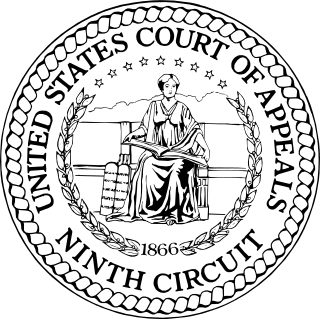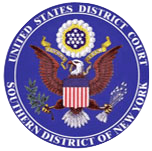Related Research Articles
Choice of law is a procedural stage in the litigation of a case involving the conflict of laws when it is necessary to reconcile the differences between the laws of different legal jurisdictions, such as sovereign states, federated states, or provinces. The outcome of this process is potentially to require the courts of one jurisdiction to apply the law of a different jurisdiction in lawsuits arising from, say, family law, tort, or contract. The law which is applied is sometimes referred to as the "proper law." Dépeçage is an issue within choice of law.

A&M Records, Inc. v. Napster, Inc., 239 F.3d 1004 (2001) was a landmark intellectual property case in which the United States Court of Appeals for the Ninth Circuit affirmed the ruling of the United States District Court for the Northern District of California, holding that defendant, peer-to-peer (P2P) file-sharing service Napster, could be held liable for contributory infringement and vicarious infringement of the plaintiffs' copyrights. This was the first major case to address the application of copyright laws to peer-to-peer file sharing.

In re Aimster Copyright Litigation, 334 F.3d 643, was a case in which the United States Court of Appeals for the Seventh Circuit addressed copyright infringement claims brought against Aimster, concluding that a preliminary injunction against the file-sharing service was appropriate, because the copyright owners were likely to prevail on their claims of contributory infringement and the fact that the services was capable of having non-infringing user was not enough reason to reverse the district court's decision. The appellate court also noted that the defendant could have limited the quantity of the infringements if he had eliminated an encryption system feature and if it had monitored the use of its systems. This made it so that the defense did not fall within the safe harbor of 17 U.S.C. § 512(i). and could not be used as an excuse to not know about the infringement. In addition, the court decided that the harm done to the plaintiff was irreparable and outweighed any harm to the defendant created by the injunction.
In conflict of laws, the choice of law rules for tort are intended to select the lex causae by which to determine the nature and scope of the judicial remedy to claim damages for loss or damage suffered.

The Uruguay Round Agreements Act is an Act of Congress in the United States that implemented in U.S. law the Marrakesh Agreement of 1994. The Marrakesh Agreement was part of the Uruguay Round of negotiations which transformed the General Agreement on Tariffs and Trade (GATT) into the World Trade Organization (WTO). One of its effects is to give United States copyright protection to some works that had previously been in the public domain in the United States.
The Copyright Act 1957 governs the subject of copyright law in India. The Act is applicable from 21 January 1958. The history of copyright law in India can be traced back to its colonial era under the British Empire. The Copyright Act 1957 was the first post-independence copyright legislation in India and the law has been amended six times since 1957. The most recent amendment was in the year 2012, through the Copyright (Amendment) Act 2012. India is a member of most of the important international conventions governing the area of copyright law, including the Berne Convention of 1886, the Universal Copyright Convention of 1951, the Rome Convention of 1961 and the Agreement on Trade Related Aspects of Intellectual Property Rights (TRIPS). Initially, India was not a member of the WIPO Copyright Treaty (WCT) and the WIPO Performances and Phonograms Treaty (WPPT) but subsequently entered the treaty in 2013.
Los Angeles Times v. Free Republic, 56 U.S.P.Q.2d 1862, is a United States district court copyright law case. Several newspapers sued the Internet forum Free Republic for allowing its users to repost the full text of copyrighted newspaper articles, asserting that this constituted copyright infringement. Free Republic claimed that they were not liable under the doctrine of fair use and the First Amendment guarantee of freedom of speech. The federal courts ruled in favor of the newspapers.

Intellectual Reserve, Inc. v. Utah Lighthouse Ministry, Inc., 75 F. Supp. 2d 1290, was a United States district court decision on the subject of deep linking and contributory infringement of copyright.
The rule of the shorter term, also called the comparison of terms, is a provision in international copyright treaties. The provision allows that signatory countries can limit the duration of copyright they grant to foreign works under national treatment to no more than the copyright term granted in the country of origin of the work.

Bridgeman Art Library v. Corel Corp., 36 F. Supp. 2d 191, was a decision by the United States District Court for the Southern District of New York, which ruled that exact photographic copies of public domain images could not be protected by copyright in the United States because the copies lack originality. Even though accurate reproductions might require a great deal of skill, experience and effort, the key element to determine whether a work is copyrightable under US law is originality.
Fair dealing is a limitation and exception to the exclusive right granted by copyright law to the author of a creative work. Fair dealing is found in many of the common law jurisdictions of the Commonwealth of Nations.
The copyright law of the United States grants monopoly protection for "original works of authorship". With the stated purpose to promote art and culture, copyright law assigns a set of exclusive rights to authors: to make and sell copies of their works, to create derivative works, and to perform or display their works publicly. These exclusive rights are subject to a time limit, and generally expire 70 years after the author's death or 95 years after publication. In the United States, works published before January 1, 1926, are generally considered public domain.
Substantial similarity, in US copyright law, is the standard used to determine whether a defendant has infringed the reproduction right of a copyright. The standard arises out of the recognition that the exclusive right to make copies of a work would be meaningless if copyright infringement were limited to making only exact and complete reproductions of a work. Many courts also use "substantial similarity" in place of "probative" or "striking similarity" to describe the level of similarity necessary to prove that copying has occurred. A number of tests have been devised by courts to determine substantial similarity. They may rely on expert or lay observation or both and may subjectively judge the feel of a work or critically analyze its elements.
A&M Records, Inc. v. Napster, Inc., 114 F.Supp.2d 896 (2000), was the district court case which preceded the landmark intellectual property case of A&M Records, Inc. v. Napster, Inc., 239 F.3d 1004 (2001). The case was heard by Judge Marilyn Hall Patel of the United States District Court for the Northern District of California. Napster appealed this case to United States Court of Appeals for the Ninth Circuit.

Arista Records LLC v. Lime Group LLC, 715 F. Supp. 2d 481, is a United States district court case in which the Southern District of New York held that Lime Group LLC, the defendant, induced copyright infringement with its peer-to-peer file sharing software, LimeWire. The court issued a permanent injunction to shut it down. The lawsuit is a part of a larger campaign against piracy by the Recording Industry Association of America (RIAA).

Columbia Pictures Industries, Inc. v. Redd Horne, Inc., was a copyright infringement case of the United States Court of Appeals for the Third Circuit over the playing video cassettes in-store of a video sale and rental store. The appeals court affirmed the decision of the district court to grant the plaintiffs' motion for summary judgment and enjoin defendants from exhibiting plaintiffs' copyrighted motion pictures.
Warner Bros. Entertainment v. WTV Systems is a 2011 copyright infringement case decided in United States District Court, C.D. California.

Wolk v. Kodak Imaging Network, Inc., 840 F. Supp. 2d 724, was a United States district court case in which the visual artist Sheila Wolk brought suit against Kodak Imaging Network, Inc., Eastman Kodak Company, and Photobucket.com, Inc. for copyright infringement. Users uploaded Wolk's work to Photobucket, a user-generated content provider, which had a revenue sharing agreement with Kodak that permitted users to use Kodak Gallery to commercially print (photofinish) images from Photobucket's site—including unauthorized copies of Wolk's artwork.

Barclays Capital Inc. v. Theflyonthewall.com, Inc., 650 F.3d 876, was a case decided in the United States Court of Appeals for the Second Circuit where the Second Circuit, reversing the decision of the US District Court below it, found that the claims of three major financial investment firms against an internet subscription stock news service (theflyonthewall.com) for "Hot-news" Misappropriation under state common law doctrine could not stand, as they were pre-empted by several sections of the Federal Copyright Act.
Penguin Books Ltd. v. India Book Distributors and Others, was a decision of the Delhi High Court issued in 1984. Penguin Books Ltd. of England brought a suit for perpetual injunction against the respondents, India Book Distributors of New Delhi, to restrain them from infringing Penguin's territorial license in 23 books, the subject matter of the suit.
References
- 1 2 3 4 5 6 Itar-Tass Russian News Agency v. Russian Kurier, Inc., 153F.3d82 (2d Cir.1998).
- 1 2 3 Itar-Tass Russian News Agency v. Russian Kurier, Inc.; also known as "Itar-TASS I", 886F. Supp.1120 , 1131(S.D.N.Y.1995).
- ↑ Copyright.ru/Zeta: Международная регистрация авторских прав Archived 2006-10-04 at the Wayback Machine ; ("International copyright registration"); in Russian. URL last accessed 2006-08-24.
- 1 2 3 4 Koeltl, J.G. (district judge): Itar-Tass Russian News Agency v. Russian Kurier, Inc. , No. 95 Civ. 2144(JGK), (S.D.N.Y. March 10, 1997). District court's ruling in this case.
- ↑ Podshibikhin, L. I.; Leontiev, K. B.: Реализация в Российской Федерации положений Бернской конвенции об охране литературных и художественных произведений [ permanent dead link ] ("The implementation of the Berne Convention in the Russian Federation"), here footnote 14. April 25, 2002; in Russian. URL last accessed 2007-01-25.
- ↑ See e.g. Geller, P.E.: International Copyright: An Introduction, §§6(2)-6(3), in Geller, P.E.; Nimmer, M.B. (eds.): International Copyright Law and Practice, INT-221 to INT-253 passim; 2001.
- ↑ Partridge, M.V.B.: Choice of Law in International Copyright Disputes Archived 2013-10-21 at the Wayback Machine , 1998. URL last accessed 2006-08-14.
- 1 2 3 See e.g. Wiener, J.L. (circuit judge): Alameda Films et al. v. Authors Rights Restoration Corp., Inc., et al., United States Court of Appeals for the Fifth Circuit, No. 01-20869; March 19, 2003. URL last accessed 2006-08-24.
- ↑ Johnson, P.: Which law applies? A reply to Professor Torremans , Journal of Intellectual Property Law & Practice 2005 1(1), pp. 71–76. URL last accessed 2006-08-25.
- 1 2 U.S. Code: 17 USC 104A. URL last accessed 2006-08-25.
- ↑ Casenotes (2007). Copyright Law: Gorman Ginsburg (7th ed.). Wolters Kluwer. p. 146. ISBN 978-0-7355-6176-2.
- ↑ FROM ITAR-TASS TO FILMS BY JOVE: THE CONFLICT OF LAWS REVOLUTION IN INTERNATIONAL COPYRIGHT
- ↑ Symeon Symeonides (2008). American Private International Law. Kluwer Law International. p. 340. ISBN 978-90-411-2742-6.
- ↑ http://kluwercopyrightblog.com/2013/05/28/french-supreme-court-on-52-bc-national-law-determines-who-is-the-copyright-owner/
